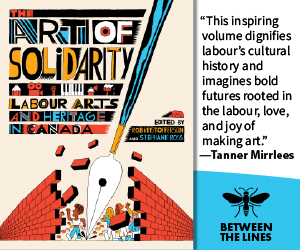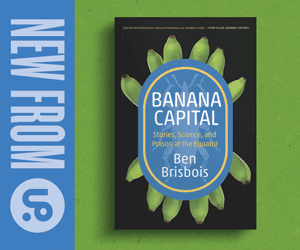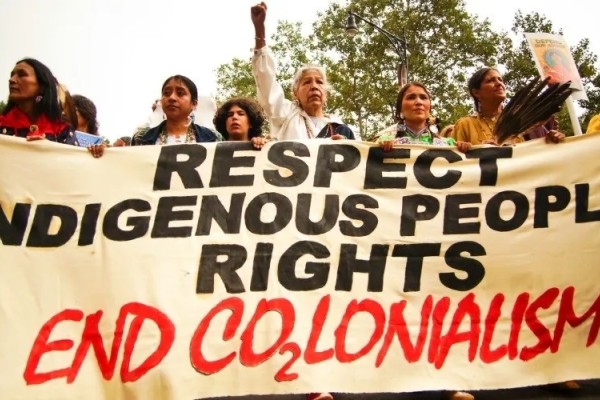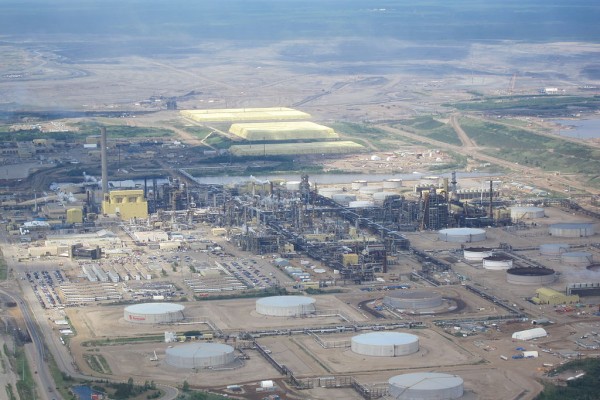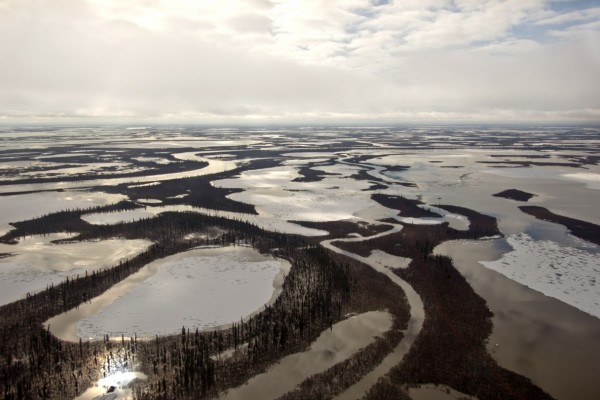Trudeau hosts biodiversity summit while promising more support for mining industry
Any changes that come out of COP15 are only meaningful if they respect Indigenous rights everywhere in Canada
Canadian PoliticsEnvironmentIndigenous PoliticsCanadian Business

Justin Trudeau addresses a crowd at the United Nations Biodiversity Conference. Photo by UN Biodiversity/Flickr.
The United Nations Biodiversity Conference, also known as COP15, opened on December 7 in Montréal. With representatives from nearly 200 countries in attendance, the conference deals with how member countries can move toward sustainable development in accordance with the UN Convention on Biological Diversity (CBD), first signed by 150 countries at the Rio Earth Summit of 1992. The CBD’s main objectives are “the conservation of biological diversity, the sustainable use of the components of biological diversity, and the fair and equitable sharing of the benefits arising out of the utilization of genetic resources.”
At COP15’s opening ceremonies, Prime Minister Justin Trudeau lavished praise on Canada’s “openness and diversity” and the natural beauty of Canadian landscapes, stating, “When people think of Canada around the world, they think of our landscapes and the richness and wealth of our nature.”
However, he stopped partway through his remarks when a group of Indigenous land defenders gathered in the middle of the room, unfurling a banner that read “Indigenous genocide = Ecocide, To save biodiversity stop invading our lands.” They drummed and chanted “Canada is on Native land” and “Trudeau is a colonizer” until security led them out of the room.
Trudeau used the opportunity to praise Canada once again. “As you can also see,” he said, “Canada is a place of free expression, where individuals and communities are free to express themselves openly, and strongly, and we thank them for sharing their perspectives.”
“Trudeau is a colonizer” - Indigenous land defenders interrupt Justin Trudeau’s opening remarks at #cop15 @APTNNews pic.twitter.com/RobAAwwQyW
— Emelia Fournier (@emelia_fournier) December 6, 2022
The elephant in the room at COP15 is that Canada, while claiming to be a global champion in environmental protection, is proportionally more environmentally destructive than other G7 countries. This destruction is inextricably entwined with the colonial processes of dispossession by which Indigenous peoples are surveilled, criminalized, and removed from their lands to make way for extractive industry such as mining and fossil fuel production.
The United Nations itself has condemned Canada’s treatment of Indigenous land defenders and called multiple times on the government to stop criminalizing their activities in defence of Indigenous cultures, biodiversity, and ecological integrity. These actions are especially important to consider in the midst of COP15, as Indigenous territories account for roughly 22 percent of the world’s land but hold 80 percent of its biodiversity—the same biodiversity that the Canadian government assures the world it is protecting.
Journalists have been detained for covering the repression of land defenders in Canada, including at Wet’suwet’en communities’ resistance to pipeline construction in northern British Columbia. In one case, two journalists who were present during an RCMP attack on a tiny house in Coyote Camp on Wet’suwet’en land were detained and prevented from covering the RCMP’s activities at the site. An internal RCMP email justified the arrest by saying that the journalists lacked “impartiality.”
One of the detained journalists, Amber Bracken, later recalled: “Police wore both regular blue uniforms and a militarized green version, the latter laden with assault rifles and tactical equipment. The scene has already become known across Canada—police dogs barking and whining as officers used an axe and a chainsaw to enter the small structure to arrest seven unarmed and peaceful individuals.”
Land defenders have also faced police repression for opposing environmentally harmful mining projects. In one famous case in 2008—sixteen years after Canada became a signatory to the CBD—the Canadian state arrested six leaders of the Kiichenumaykoosib Inninuwug (Big Trout Lake) First Nation for protesting mineral extraction on their lands. Similar conflicts continue across Canada to this day, with the colonial state and extractive industry on one side and land defenders urging proper consultation and respect for biodiversity on the other.
One such example is Ontario’s Ring of Fire, where Indigenous communities opposed to mineral exploitation have accused the provincial government of acting duplicitously, seeking to circumvent Indigenous-led environmental assessment measures, and disregarding the fact that the destruction of the region’s “carbon sink” peatlands will exacerbate the global climate crisis.
In early 2022, the chiefs from Attawapiskat, Eabametoong, Fort Albany, Kashechewan and Neskantaga sent a joint letter to federal Environment Minister Steven Guilbeault in which they said that “rampant mining development could not only destroy this globally critical carbon sink, but release its huge store of carbon and escalate climate change further into catastrophe.” Attawapiskat Chief David Nakogee said that the chiefs “didn’t get much of a response” from the minister.
Earlier this month, a study by the Justice and Corporate Accountability Project (JCAP) matched the findings of the UN regarding the criminalization of land defenders in Canada. The study, entitled The Two Faces of Canadian Diplomacy: Undermining Human Rights and Environment Defenders to Support Canadian Mining, found that the Canadian government’s disregard for the crimes of extractive industry has led to threats against local communities, the criminalization of people opposed to the projects, attacks, arrests, and killings. Report co-author Charis Kamphuis stated:
Human rights and environment defenders play a critical role around the world protecting biodiversity and seeking solutions to the global ecological crisis… Yet there is overwhelming evidence that Canadian officials systematically ignore Canada’s own policies when it comes to corporate accountability and the protection of defenders. These policies are effectively rendered meaningless.
Following the publication of the study, Jamie Kneen of MiningWatch Canada related its findings to the ongoing COP15 summit:
We’re already seeing Canadian officials make important commitments regarding biodiversity protection during COP15. But this report makes clear that Canada does not follow its own policies when it comes to supporting the very people that dedicate their lives to protecting the environment at great personal risk.
Now, with talk of a sustainable energy transition popular amongst Western states, the federal and provincial governments are developing “critical minerals strategies” which will see increased mineral extraction in the coming years. The most recent critical minerals strategy paper, released in the midst of COP15, highlights the importance of mineral extraction and the expanded role that the Canadian state will play in supporting the domestic mining industry.
MiningWatch offers the following summation of the new strategy paper:
Canada’s Critical Minerals Strategy places a welcome emphasis on value-added manufacturing, high standards for environmental and human rights protection, Indigenous rights, and circular economy. However, those principles are not backed with proposals for meaningful implementation, and they are rendered almost meaningless by the strategy’s central thrust—deepened and accelerated extraction of raw materials for global markets. There is no recognition of the material implications of the Paris commitments to address the climate crisis, much less of already-strained planetary limits, beyond laudable but merely conceptual mentions of recycling and circular economy.
Since its inception, the Canadian state has supported extractive industry domestically and internationally—in fact, many would argue that these were the interests that motivated the creation of Canada as a nation in the first place. Now, in the era of “renewable energy,” the state’s industry support is being rebranded as “sustainable” with little in the way of substantive adaptation to the myriad ecological crises facing humanity.
“[The Critical Minerals Strategy] is basically Canada’s ‘business as usual,’” MiningWatch explains:
extraction, processing, and shipping raw materials, with limited ‘branch plant’ manufacturing, reconstituted with added emphasis on value-added processing… it fails to contemplate measures that would even remotely allow Canada to address the climate crisis in a meaningful way, and in fact promotes measures that will lead to a deepening of not just the climate crisis but also other planetary crises, biophysical as well as socio-political and economic, including inequality, democratic governance, migration, and human security.
While Trudeau stood on stage at COP15 and declared “Nature is under threat… In fact, it’s under attack,” his government released a Critical Minerals Strategy that fails to adequately address ecological degradation and the rights of land defenders. Furthermore, the strategy paper includes numerous gifts to the industry contributing to the attack on nature—an attack the prime minister supposedly laments. These gifts include industry subsidies and tax breaks like the 30 percent Critical Mineral Exploration Tax Credit for targeted minerals.
The strategy paper also commits to “Accelerating Responsible Project Development.” However, the government’s definition of “responsible” is obviously a rather lenient one, given that it recently approved the Marathon Palladium mine despite “acknowledged significant environmental impacts.”
Valerie Courtois, Director of the Indigenous Leadership Initiative and a member of the Innu community of Mashteuiatsh in Québec, says that in Canada “the vast majority of conservation proposals and stewardship initiatives are being led or co-led by Indigenous peoples.” But this is not enough. Any changes that come out of COP15 are only meaningful if they respect Indigenous rights everywhere in Canada, including in regions to which extractive companies want access. Until these companies are reined in, and until the dispossessive actions of Canadian police institutions are truly reckoned with, Trudeau’s promises at COP15 will be mostly window-dressing.
Ta’Kaiya Blaney, a Tla-Amin Nation activist who interrupted Trudeau’s COP15 remarks, said in a news conference:
[The protest] was our way of showing as Indigenous people from the west coast that [Trudeau] is not following our laws, that he is not following the laws of the land, and that we cannot accept any more empty promises from Canadian politicians about our futures… Empty promises, false solutions and fictional targets…that do nothing but pass off the burden to future generations are unacceptable.
“I’m not here to fight for recognition,” Blaney added. “I’m here to fight for sovereignty, and that is different. I’m not asking the United Nations or Canada to recognize our nation as, in all of our belonging and our rights, I’m asking them to stop invading us.”
Owen Schalk is a writer based in Winnipeg. He is primarily interested in applying theories of imperialism, neocolonialism, and underdevelopment to global capitalism and Canada’s role therein. Visit his website at www.owenschalk.com.


